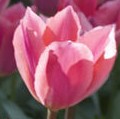 Tulips are spring-blooming perennial bulbs that do well in in many areas of the US. They grow best in areas where summers are dry and winters are cold so thrive in mountainous areas of the West They originated in the mountains of the Middle East and were cultivated and sold by the Ottoman Empire. The Europeans became so infatuated with tulips between 1634 and 1637 that “tulip mania” broke out as the wealthy speculated on them and used them as currency. Tulips belong to the lily family (Liliaceae) and have strap shaped leaves, and cup shaped flowers composed of three brightly colored petals and three similar sepals. Tulips may be any color except blue and multi-colored flowers are available as well as double flowers and flowers with petals that have fringed or ruffled margins. Although they are perennial, most of them diminish in vigor and attractiveness after the first year. There are exceptions, however, and if the return of attractive tulips is important choose the small-flowered species tulips rather than the large-flowered Dutch hybrids. The small -lowered tulips are not the ones you are most likely to want for culinary purposes because of their size of the flowers but they are reliably perennial. The common and generic names (tulip, Tulipa, respectively) may come from the Turkish word referring to a turban.
Tulips are spring-blooming perennial bulbs that do well in in many areas of the US. They grow best in areas where summers are dry and winters are cold so thrive in mountainous areas of the West They originated in the mountains of the Middle East and were cultivated and sold by the Ottoman Empire. The Europeans became so infatuated with tulips between 1634 and 1637 that “tulip mania” broke out as the wealthy speculated on them and used them as currency. Tulips belong to the lily family (Liliaceae) and have strap shaped leaves, and cup shaped flowers composed of three brightly colored petals and three similar sepals. Tulips may be any color except blue and multi-colored flowers are available as well as double flowers and flowers with petals that have fringed or ruffled margins. Although they are perennial, most of them diminish in vigor and attractiveness after the first year. There are exceptions, however, and if the return of attractive tulips is important choose the small-flowered species tulips rather than the large-flowered Dutch hybrids. The small -lowered tulips are not the ones you are most likely to want for culinary purposes because of their size of the flowers but they are reliably perennial. The common and generic names (tulip, Tulipa, respectively) may come from the Turkish word referring to a turban.
The taste of tulip petals is mild like lettuce and cucumbers, flavors that are refreshing in summer drinks and salads. The best use of tulip flowers,however, is perhaps as containers for other foods like ice cream, cheese, and chicken, egg or seafood salad. The vivid color of some tulip petals also makes them an excellent garnish.
When using tulips for culinary purposes, do NOT use those bought at the grocery story or florist because they have probably been sprayed with pesticides. The only way to be sure that the flowers are chemical free is to grow them yourself. After harvesting the flowers, gently wash them, and then pull out the pistils and stamens in the center. Three to seven flowers yields one cup of petals.